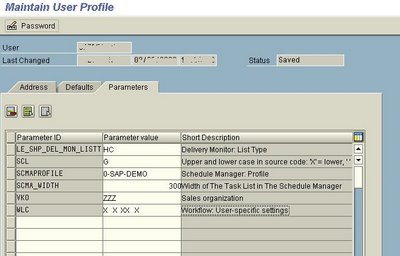User parameters (PARAMETER ... MEMORY ID)
Tuesday, October 03, 2006
The company that I currently work for has just recently implemented SAP at one of the locations and now we are working on the implementation at another location. We have several custom transactions where users must enter an ID (Sales Organization, Plant, etc.) of their location. Naturally, we started thinking what we could do so that the users wouldn’t need to type those IDs again and again. (In case you are wondering – we were simply too busy to think about it during the first implementation.)
So last week I went to talk to our security administrator and she told me that she’s been entering all the applicable organizational IDs on the user profiles. There are other transactions for the user profile maintenance (e.g. SU01), which most likely you will not be authorized to use, but she showed me this one, SU3 with the Parameters tab:

At first I thought that we will have to find some function module and get those parameters somehow by user ID. But then I realized that those parameters can actually be used in the MEMORY ID addition to the PARAMETER command. If, for example, a user has the parameter VKO = ZZZ in SU3, then p_vkorg will be populated with ZZZ by default when the user runs the program below. Here I also check if the user has authorization to display the data for this sales organization:
PARAMETER: p_vkorg TYPE vkorg MEMORY ID VKO.
AUTHORITY-CHECK OBJECT 'V_VBRK_VKO'
ID 'VKORG' FIELD p_vkorg
ID 'ACTVT' FIELD ‘03’.
IF sy-subrc <> 0.
* display error message here.
ENDIF.
Here are some other useful memory IDs:
BUK - Company code (BUKRS)
EKO - Purchasing Org (EKORG)
LAG - Storage Location (LGORT)
LGN - Warehouse Number (LGNUM)
WRK - Plant (WERKS)
The memory IDs are stored in the TPARA table, there are like thousands of them. Not sure if those parameters have any other use and if the custom parameters could be maintained and how... I’ll let you know if and when I find out.
By the way, while I was playing around with this, I found that WERKS is actually a structure. While it’s OK to define the parameters with TYPE VKORG, it is better not to define them with TYPE WERKS. Use TYPE WERKS_D instead.
posted by Your Friendly ABAPer @ 22:40,
![]()
![]() Direct link to this post
Direct link to this post
2 Comments:
- At 31/3/09 06:00, PrinceW said...
-
This article is very helpful. Thank you.
- At 7/3/12 04:40, said...
-
Really very helpful


